The history of Brain is written by Professor Emeritus Alastair Compston, former Professor of Neurology, University of Cambridge, and former editor of Brain journal (2004 - 2014).
Brain, a journal of neurology has been published continuously since April 1878. For 147 years, the journal has been a leading repository of knowledge on the nervous system in health and disease. From the outset, each issue combined original articles with commentaries. After a successful first decade during which the four founding editors took responsibility for the quarterly issues published by Macmillan and Co., they and others formed the Neurological Society of London (later, the United Kingdom). This adopted Brain as its official journal. With their finances inextricably linked, both remained viable but never wealthy. The growth of specialist societies waned towards the end of the nineteenth century. In 1907, the Neurological Society of the United Kingdom became the neurological section of the Royal Society of Medicine. This left Brain without a patron. A group of individuals agreed to secure the finances and continue publication as an independent business dependent on subscriptions and underwritten by the ‘Guarantors of Brain’.
After 1907, a Committee of Management assumed executive authority on behalf of the Guarantors. Apart from book reviews, the contents were now largely confined to original articles. The editors served without limitation of tenure. At first, the style was for long papers written by the elite of British and international neurology. Monograph length articles described the clinical and pathological features of newly identified conditions; and the effects of injuries of the brain and spinal cord sustained during the First World War. Subsequently, the preference was for shorter papers written by a broader community, including talented trainees. Many dealt with normal structure and function. The implications for disease were not necessarily explicit. Copy was short during the Second World War, but over the next thirty years to 1975, the editors responded to emerging interests such as disorders of higher cerebral function and diseases affecting nerve and muscle. Articles increasingly used methods, especially neurochemistry, which elucidated the mechanisms of disease. The experience of neurosurgery and neurology in the general medical setting of regional centres became prominent. And Brain documented the introduction of treatments that were increasingly effective.
Starting in 1920, the Guarantors periodically subsidised the publication of books celebrating the achievements of British neurology. Skilfully edited, these reflective contributions narrated the steady evolution of ideas on the nervous system. But they were not financially successful. Over decades, relationships with Macmillan became increasingly strained. In 1975, patience finally expired so that, after ninety-seven years, publication of Brain moved to Oxford University Press.
The story of Brain thereafter is one of expansion and wealth. The journal gradually shook off its reputation for long descriptions of structure and function based on physiological methods, supplementing classical clinicopathological description with the newer disciplines of immunology, molecular genetics and brain imaging. With a steady increase in submissions, publication changed to six issues per year; then the use of larger paper and printing in double columns; and, finally, the switch to monthly issues. A more radical change was the decision, from 2003, to manage the journal online and no longer accept paper copies. Although the contents of each issue were available through the website, Brain was also printed within a fixed page budget. As a result, the acceptance rate for submissions fell below 20%. During the 1960s, Brain employed an editorial assistant to administer the journal. Over time, this expanded to four employees. After the millennium, each issue included editorials and a range of contents, variously categorised, other than original articles. The aim was to make Brain a repository of contemporary knowledge set in its cultural and historical background. Following discussion over several years, both for commercial reasons and to manage the low acceptance rate, a second journal was launched online in 2019: Brain Communications.
After the 1970s, the treasurers of Brain no longer had to worry about financial viability. As a charity with increasing assets, schemes were introduced which supported training for clinicians and scientists working on the nervous system. Initially modest in scale, these provided travel grants to attend international meetings; funds for visiting bursaries; and partial support of domestic conferences. Later, at a time when other agencies started to withdraw from training, the Guarantors provided transitional funding for clinicians at difficult stages of entry and exit from clinical to scientific training; three-year doctoral fellowships for scientists working in a clinical environment; and an expanding number of clinical training fellowships.
Almost 150 years after Brain was founded, the Guarantors remain responsible for a well-established and successful journal; and they support the aim of the four founding editors to promote a community that works to illuminate the scientific basis of clinical neurology.
Read more:
The history of Brain falls into three periods: 1878–1906, when the journal was founded, established its reputation, and became aligned with the Neurological Society of London (later, United Kingdom); 1907–1975, when responsibility devolved to the Guarantors, the reputation of Brain as the leading journal of neurology was consolidated, but financial security never firmly achieved; and 1976–present when Brain emerged stronger from competition in a climate dominated by bibliometrics, and wealth accumulated after publication moved to Oxford University Press enabling the Guarantors increasingly to function as a charity supporting training in the clinical neurosciences.
1878–1907.
There was no certainty of success when Brain, a journal of neurology first appeared in April 1878, edited by John Bucknill (1817–1897), James Crichton-Browne (1840–1938), David Ferrier (1843–1928) and John Hughlings Jackson (1835–1911). Brain filled a gap left by the now defunct West Riding Lunatic Asylum Medical Reports (1871–1876), which Crichton-Brown had edited. Within a few years Brain was the foremost journal publishing on the emerging specialty of clinical neurology, and enjoying a national and international readership.
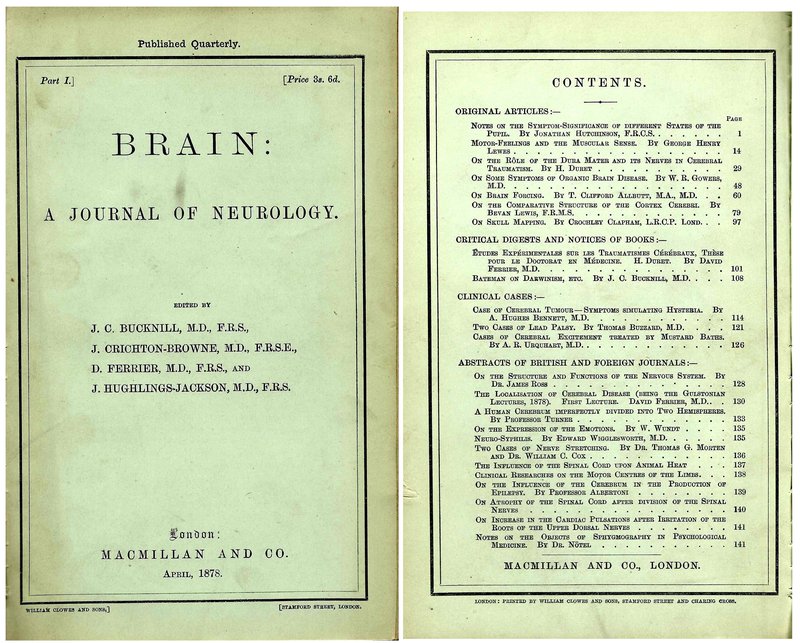
The front cover, and contents on the back cover, for the first issue of Brain, April 1878.
The journal was to appear quarterly at an annual subscription of 14s (3s. 6d. per issue). The contents were in four sections: original articles; critical digests and notices of books; clinical cases; and abstracts of British and foreign journals. The aim to provide so much coverage of the independent literature meant that help was needed beyond the efforts of the editors, whose contributions were uneven: Crichton-Browne and Ferrier were industrious; Hughlings-Jackson made occasional editorial contributions; and Bucknill restricted himself to the laws on lunacy and historically orientated pieces. In time this quartet looked for a successor. For 1887, Armand de Watteville (1846–1925) was designated ‘Acting Editor’; and Thomas Buzzard (1831–1913) and James Ross (1837–1892) joined the four founders as the editorial committee.
Now came a highly significant change. Formalities for founding the Neurological Society of London concluded on 14 January 1886. This initiative reflected a general trend towards specialism, as the grip of the established medical and surgical societies loosened and smaller groups aspired to independence. In the climate of the 1880s, the community of physicians specialising in diseases of the nervous system was ready to secede from the existing societies. The Neurological Society had in Brain a ready-made and successful journal in which to publish work discussed at its meetings. For Brain, devolving financial responsibility alleviated concern that, with unrestrained allowance of extravagant illustrations, income from subscriptions did not always meet the costs of production. From April 1887, Brain was ‘Edited for the Neurological Society of London by A. de Watteville’.
The ‘Rules and List of Office Bearers and Members’ with their dates of election to the Society were published in 1891. The annual fee was £1 per annum, which included a subscription to Brain (discounted to 11s.) The aims of the Society to develop the practice and scientific basis of neurological medicine were reflected in the domestic and foreign membership; in the selection of presidents and officers; and through the structure of clinical and scientific programmes. Of the eighty-four original members, all but twenty-two had addresses in central London.
The Society met several times each year. Scientific discussions were devoted to specific topics; the ordinary meetings included a diverse range of clinical cases and pathological exhibits. The independently printed annual report was usually bound with each volume of Brain; but, from 1897, a more detailed section on proceedings of the Neurological Society was incorporated within the journal. Between January 1887 and March 1907 when it was disbanded, the Neurological Society met on one hundred and thirty-two occasions during which at least five hundred and twenty-five presentations were made. These led to a minimum of one hundred and twenty-one publications in scientific journals. Of these, ninety-three can be linked to articles, case reports or clinical digests in Brain.

Front cover of the issue for April 1887 showing the affiliation with the Neurological Society of London.
The relationship with the Neurological Society changed the format of Brain. Case reports became largely redundant; interest in abstracting papers published elsewhere faded; and there were fewer critical digests. With the rise of specialism, new conditions were described which linked clinical and pathological aspects of previously ill-defined disorders. Brain responded by concentrating on reviews which summarised this rapidly expanding literature. What did not diminish was the appetite for critiques of recently printed books.
There remained one constant threat to the security both of the Neurological Society and Brain. Their finances were inextricably linked and largely dependent on annual subscriptions offset by the costs of publication charged by Macmillan and Co. Membership soon saturated the metropolitan community. Recruitment from outside London helped and led to renaming as the Neurological Society of the United Kingdom. But the unrestrained use of luxurious illustration in Brain was not sustainable. Payments were required from authors; and Macmillan had to make occasional contributions to offset deficits in the annual accounts. The other financial drain was the decision taken in 1895 to produce a cumulative index of the journal to date. William Broadbent (1835–1907) gave thirty-six guineas to get the project started; but the amount of work was underestimated, the methods used proved cumbersome, and Macmillan wanted immediate payment for a print-run from which sales were disappointing. It would be going too far to argue that anxieties over expenses relating to the publication of Brain led to eventual dissolution of the Neurological Society in 1907, since other factors were threatening survival of the specialist groups which had proliferated towards the end of the nineteenth century. But, in carrying Brain, the annual net balance of the Neurological Society over the decade after 1896 reduced and was never more than £70.
When de Watteville resigned as editor in 1901 having nurtured Brain over a period of two decades, he handed over to Robert Percy Smith (1853–1941). Percy Smith’s scientific credentials were not comparable to the previous editors or their assistants and he wrote very little for the journal before or during his tenure. This lack of engagement with the content was in marked contrast to Percy Smith’s successor. Henry Head (1861–1940) also had not contributed to the editorial process or written commentaries for Brain before taking over as editor in 1905. But unlike Percy Smith, Head published original articles, almost all of prodigious length, before and after his appointment as editor.
The first thirty volumes of Brain contain 18240 pages of main text. As experimental work developed, papers on physiology and cerebral localisation, especially relating to speech and vision, became prominent. Papers appeared on function of the cerebellum. The problem of hysteria was much discussed. The clinical utility of tendon reflexes and the plantar response, and methods of investigation including electrical stimulation, began to dissect syndromes such as ‘paralysis’ and ‘ataxy’ into their cerebral, spinal, peripheral nerve and muscle components. Clinicopathological correlations consolidated the concept of conditions in which one or more defined tracts degenerated. Terms such as ‘chorea’ and ‘spasm’, ‘epilepsy’ and ‘atrophy’, became more precise as clinical experience increased. Awareness of Mendelian genetic, environmental and social contributions began to refine the concept of ‘familial’ disease. Treatments such as suspension, massage, electricity, hypnotism, and surgery to the brain, cord and peripheral nerves were explored. Pharmaceuticals entered neurological practice. Taken together, over this period the editors and those who supported their efforts provided readers of Brain with a unique record of neurology as it took shape during the latter part of the nineteenth century.
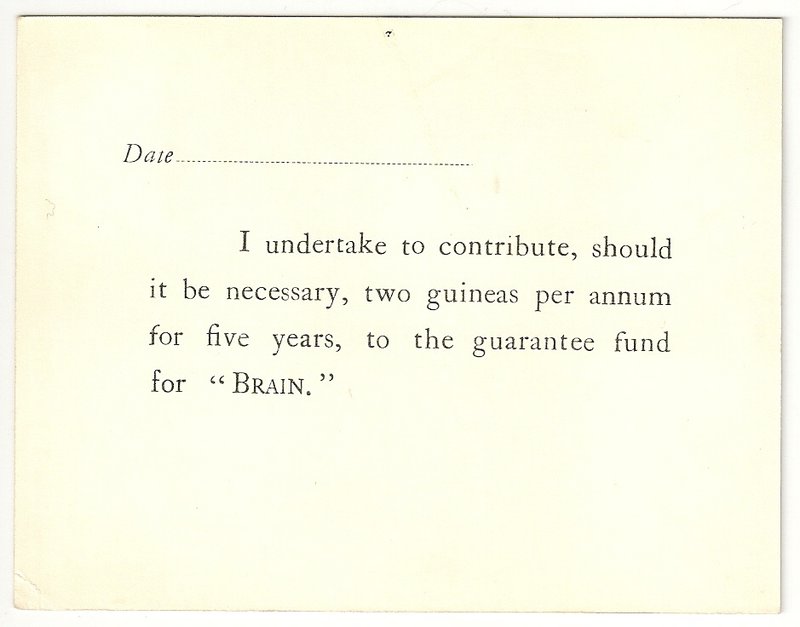
Card to be signed by each Guarantor committing to financial support of the journal: ca.1923
But Brain was about to face another crisis. Enthusiasm for creating specialist societies representing the many branches of medicine and surgery had over-reached itself. On 18 November 1905 it was resolved that ‘the Neurological Society of the United Kingdom would support the scheme to form a Union of Medical Societies’. Henry Head was delegated to negotiate arrangements; and, on 6 June 1907, the Neurological Society of the United Kingdom became the section of neurology within the renamed Royal Society of Medicine. This left Brain exposed once more to the vicissitudes of commercial publishing. In order to underwrite the possibility of financial loss, a group of clinicians and scientists agreed to guarantee survival of the journal at a nominal cost of one guinea, later reduced to two guineas for a five-year commitment. The history of the journal after 1907 is inseparable from the roll-call of these Guarantors of Brain.
1907–1975
Election as a Guarantor of Brain in 1907 risked having to pick up deficits on the finances. As it turned out, no-one was ever asked for payment, but agreeing to the pledge was an unwritten condition of appointment. An elite group of Guarantors was named on the front cover as assisting the editor in the selection of papers. This was something of a sinecure since, at the 1928 annual general meeting, it was pointed out that no one of the cover names, ‘who are supposed to assist the editor’, did in fact do so. The Guarantors were an elderly group of men. An attempt at rejuvenation was made in 1923 when everyone was ‘resigned’ but thirty were immediately re-elected. Of these, the oldest was David Ferrier (1843–1928: aged 80) and the youngest ED Adrian (1889–1977: aged 34), with an average age of 59 years. Of the thirteen newly elected Guarantors, the oldest was (William) Aldren Turner (1864–1945: aged 59) and the youngest Charles Symonds (1890–1978: aged 33), with an average age of 43 years. In 1929, it was decided that the number of Guarantors be limited to forty, new appointments filling gaps from deaths and resignations. The first woman, Helen Dimsdale (1907–1977), was elected on 20 March 1951. When it emerged in March 1954 that, as a trading company, Brain would be subject to taxation, the Guarantors of Brain became a charity, reformed on 29 July 1971 into a company limited by guarantee with maximum liability to each trustee of £1. The first of the annual dinners, hosted by the editor and attended by the Guarantors and selected guests who had contributed as referees or authors of book reviews, together with older retirees, was held in May 1962.
From the outset, the Guarantors devolved responsibility to a Committee of Management, later designated the Board or Executive Committee. Practical arrangements for each meeting and the chairmanship rotated but responsibility for the finances was entrusted to a series of treasurers, each of whom held office for many years: James Taylor (from 1907–1928), Anthony Feiling (1929–1951), and Sam Nevin (1952–1970). In 1906, membership of the Neurological Society stood at 256, and net assets were £162. The subscription for Brain was 16s. per annum (4s. per issue) discounted to 12s. for members of the neurological section of the Royal Society of Medicine and the Guarantors. Brain survived the transition but, for a while, the situation remained precarious with fewer than 200 subscribers, and the recurrent issue of expense on illustrations. At the end of the First World War, the cost of paper and other production costs left the Guarantors transiently in debt to the publishers, although cushioned by investments in war bonds. Metal for engravings was in short supply and authors hoping to have their papers illustrated were asked to return old plates. Over the next sixty years, until the 1980s, the treasurers supervised a long period of uncertain financial stability. The series of contracts with Macmillan and Co. prevented the Guarantors from ever becoming wealthy.
The tone of relationships with Macmillan and Co. began to sharpen in the 1930s and it remained intermittently tense over the next four decades. Subscriptions which had been at around 350 in the 1920s were falling. In 1935, net income to the Guarantors was £5. Submissions reduced and the page budget was under-used during the Second World War. Thereafter, delays in production led to a backlog of papers awaiting publication. Some subscribers never received their copies. Serial increases in the cost of subscription were imposed by the publisher. Stable at 24s. for twenty years from 1921, this reached £3 by 1960 and £10 in 1972. Yet despite the tensions, this was a period of outstanding reputational growth for the journal. Submission of manuscripts had increased to around 120 per annum by the late 1960s, requiring a rejection rate of 50%. But the great success was a marked increase in the number of subscriptions: from 1660 in 1955, to 3328 in 1965, and 5037 in 1975. It seemed that Brain had no rivals in the anglophone world for keeping readers up to date with developments in the clinical neurosciences.
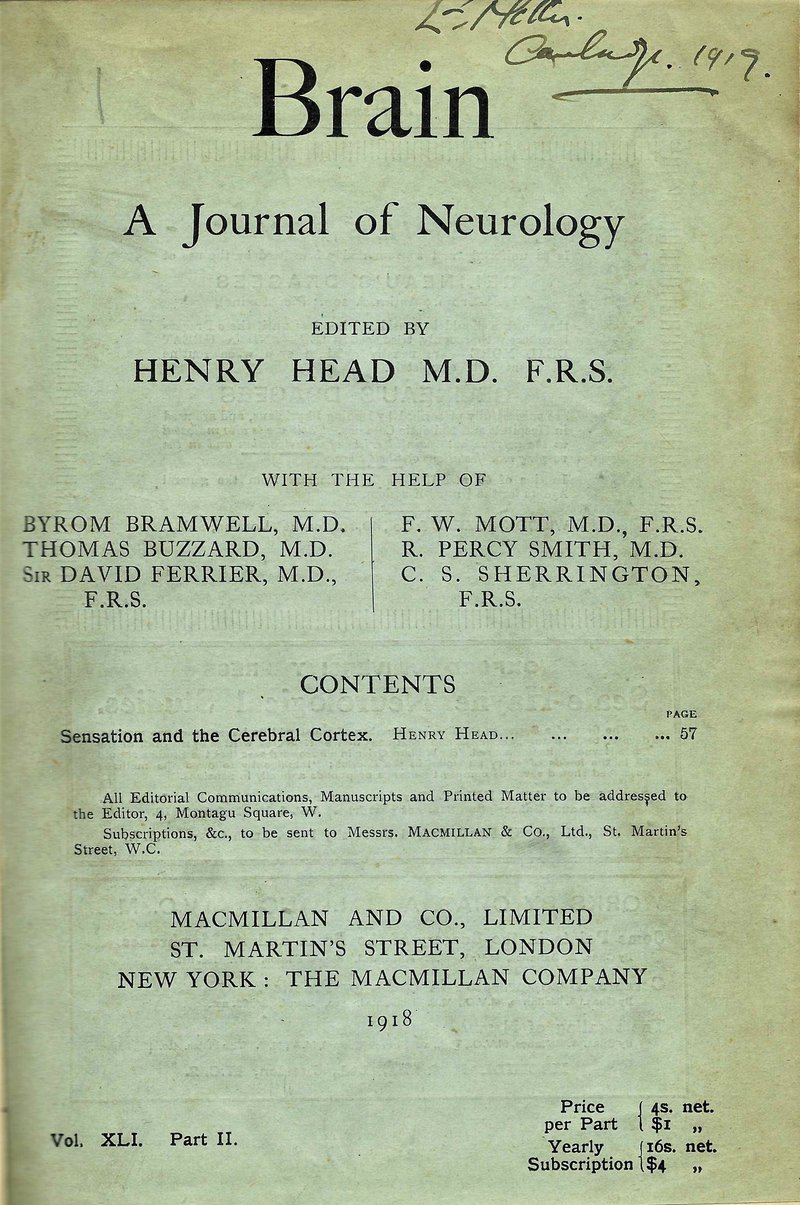
The front cover for the issue of September 1918 showing the editor and his assistants; the contents confined to a single paper of 197 pages by Henry Head.
The sixty-seven volumes of Brain published for the Guarantors by Macmillan and Co. between 1908 and 1975 contain 40872 printed pages. Routinely, there were no editorials. Very occasionally an article was designated a ‘critical review’. However, book notices continued, initially unsigned, but from the 1950s with initials and then full attribution. As editor from 1905–1922, Henry Head published long articles, many by well-known authors: Adrian, Harvey Cushing (1869–1939), William Gowers (1845–1915), Gordon Holmes (1876–1965), George Riddoch (1888–1947), Charles Sherrington (1857–1952), Kinnier Wilson (1878–1937) and, especially, himself. After 1916, Brain published definitive papers on sensation, vision, the cerebellum and spinal cord based on the effects of penetrating injuries sustained during the First World War. Head’s presidential address to the Royal Society of Medicine was published in 1918, after which proceedings of the section of neurology appeared as part of Brain until 1929. Part IV for 1961 was dedicated to Head in the centenary of his birth. Brain may have been a personal fiefdom for Head but he was custodian of the journal during what was arguably its greatest period.
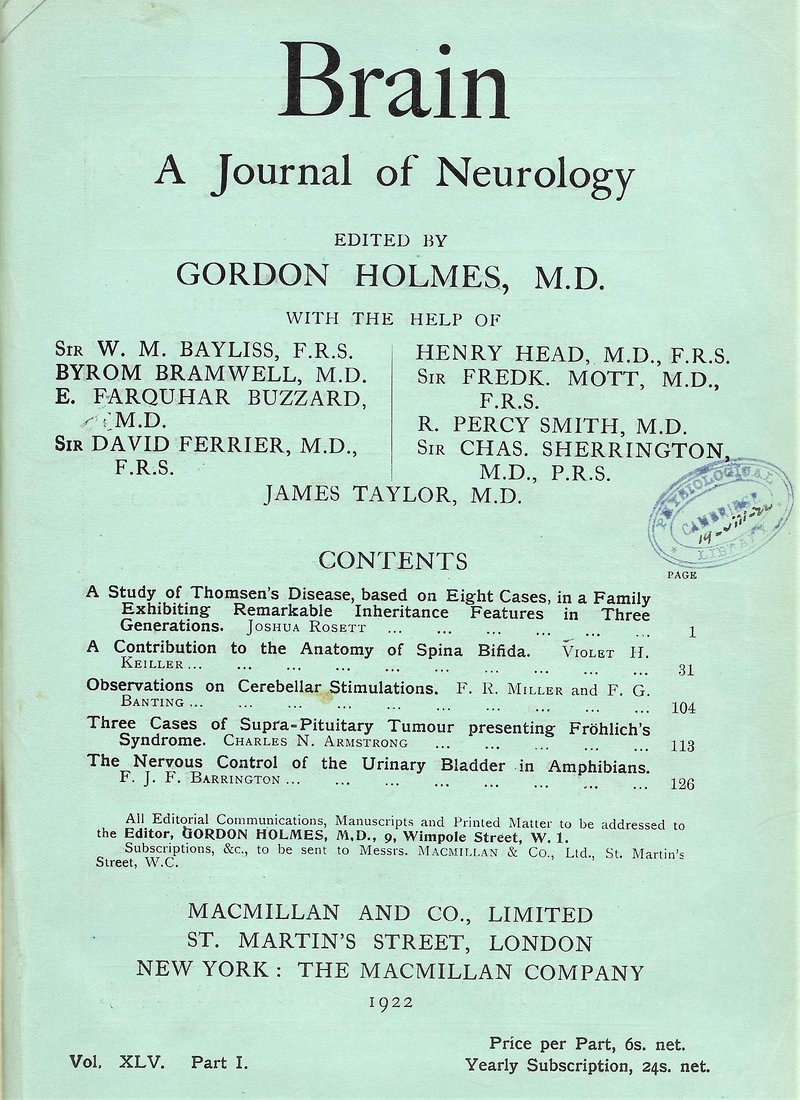
The issue for June 1922, the first to be edited by Gordon Holmes and those ‘helping’ the editor
His successor, Holmes, was tetchy in the role. In 1928, he threatened to resign if the Executive Committee did not provide assistants: Francis Walshe (1885–1973; assistant 1929–1938) and Godwin Greenfield (1884–1958; assistant 1929–1953) were duly appointed. Whilst papers from the distinguished older generation were still published, Holmes encouraged a greater mix of younger authors rising to prominence in British neurology, and foreign correspondents. The papers were shorter. But the defining feature of Brain under Holmes’s editorship was human and comparative physiology and anatomy of the brain and spinal cord. Many of these papers came from former students of Sherrington, and other departments in Oxford. Whether Sherrington was directly influential in these selections is doubtful although his name appeared on the front cover of Brain as one of those ‘helping’ the editor for 44 years from 1908–1951. Holmes wanted Brain to be affiliated with the Association of British Neurologists which he and others founded in 1933, but the executive remained loyal to the Guarantors.
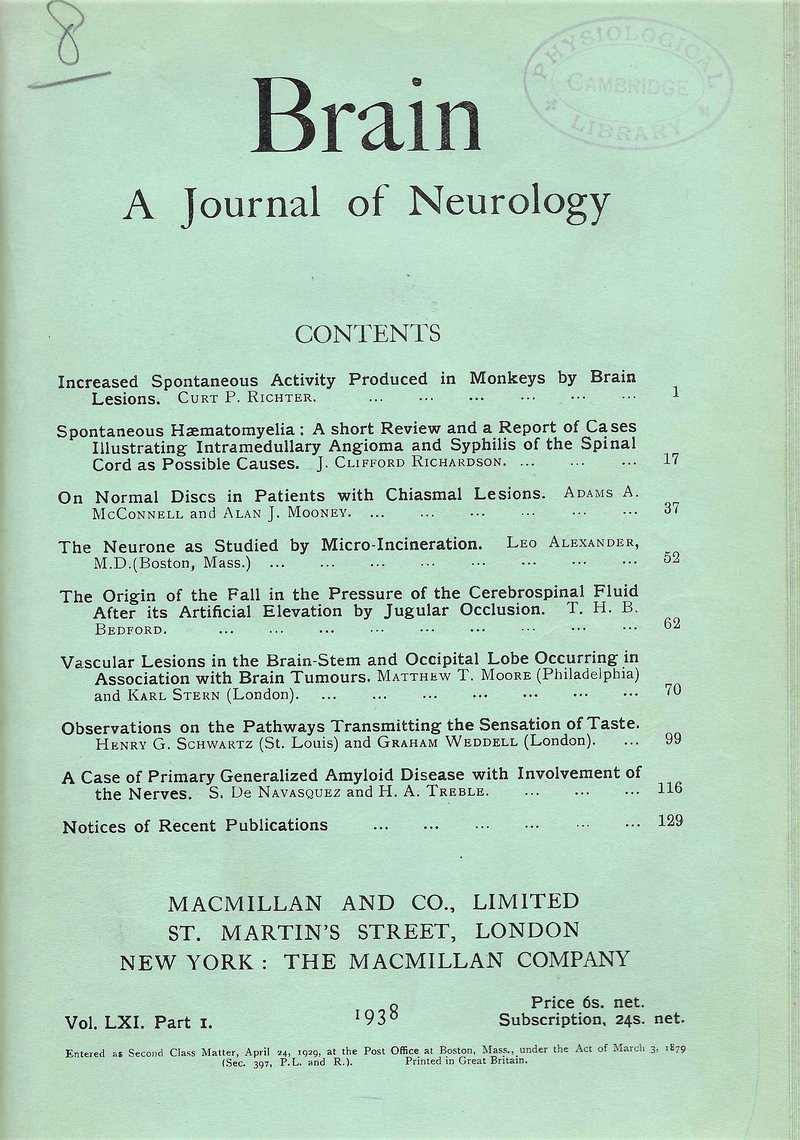
The issue for March 1938, the first edited by Francis Walshe, now showing only the contents with names and other details moved to the inside of the front cover.
When Holmes did eventually resign in 1938, Walshe was elected editor retaining Greenfield as assistant, later with Macdonald Critchley (1900–1997; assistant 1946–1953). All three had published regularly in Brain from 1914, 1919 and 1924, respectively. Names were removed from the front cover which now simply listed the contents of each issue. Despite maintaining that the dividend for clinical neurology from animal and experimental physiology had been limited, Walshe’s own papers addressed functional properties of the motor system. However, his ideas were based entirely on clinical analysis and the work was never experimental. Walshe was keen to promote other disciplines, especially neurochemistry, on which John Cumings (1905–1974) was a frequent contributor; and clinical use of the electroencephalogram first described in Brain by Adrian during the 1930s. Nonetheless, papers from Oxford and elsewhere on experimental physiology and descriptive anatomy of the normal human and animal central nervous system retained their grip on the contents. Although Walshe wrote often in Brain during his editorship, unlike Head this was not so much a matter of using the editorial opportunity to his own advantage but because, during and after the Second World War, copy was short. Many volumes in this period were half the size of those before and after the early 1940s. When papers which reflected the experience of neurology during the Second World war did appear, the emphasis was on peripheral nerve disease. Under Walshe’s editorship, Brain started to publish papers on treatments of neurological disease, including Hugh Cairns (1896–1952) on the use of penicillin in brain and meningeal disease; and Milton Shy (1919–1967) and James Austin (b.1925) on the use of cortisone in acute neurological conditions.
Walshe resigned in 1953. Charles Symonds declined the editorship and Russell Brain (1895–1966) was appointed. The executive had met on 29 July 1952 and advised that the editorial committee should comprise an anatomist, physiologist, pathologist, psychiatrist and two or more neurologists. The assistant editor was Denis Williams (1908–1990; assistant 1954–1966). Brain was the first to employ a non-medical editorial assistant to administer the journal. The formidable Elizabeth Macdougall remained with the journal until October 1991. One change under Brain’s editorship was the greater emphasis on higher cerebral function with regular contributions on aphasia and disorders of visual perception. These included papers by Oliver Zangwill (1913–1987), Alexander Luria (1902–1977), Critchley, William Gooddy (1916–2002), and the 1965 review in two parts on disconnection syndromes in animals and man by Norman Geschwind (1926–1984). Regional centres for neurosurgery developed in the 1950s based in district general and provincial University hospitals, and neurology tagged along. As a result, papers on neurosurgery, large case series of common neurological disorders, and the neurology of general medicine, all relatively unfamiliar to experience in central London, written from new regional centres, especially Birmingham, Cardiff and Newcastle as well as the older established units in Edinburgh, Manchester and Oxford, flourished in Brain. With stabilisation of finances in the 1950s through rapid increase in subscriptions, the contents of Brain expanded with a return to luxurious illustration using photographic plates, and folding tables on thick paper. For example, volume LXXXI for 1958 had 92 plates, several printed in colour.
Lord Brain died in office on 29 December 1966. Revised editorial arrangements were proposed with an editor-in-chief and editorial board of six individuals. Tenure of appointment would be limited to seven years and lapse at aged 65. Denis Williams was elected editor-in chief and, in the event, served until 1975. Brain continued to publish on human and comparative physiology and anatomy of the brain in health and disease, including a series of five papers on spasticity by Peter Nathan (1914–2002); and on the effects of disease on higher cerebral function. But new topics were emerging. Prominent amongst articles in Brain were paraneoplastic disorders, a special interest of Lord Brain and the theme of part II for 1965; disorders of muscle, especially from Newcastle written by Frederick Nattrass (1892–1979) and John Walton (1922–2016); a series on the spongiform encephalopathies in animals and man; and papers on cerebrovascular disease, including Alf Brodal (1910–1988) describing the personal experience of a brainstem stroke. The change that Walshe and Lord Brain had begun and Williams continued was the transition from physiology and anatomy to newer methods of investigation needed to understand mechanisms of disease. Williams was replaced as editor by Charles Phillips (1916–1994), the year before publication moved to Oxford University Press ending the long association with Macmillan and Co.
Comfortable but never financially secure prior to 1975, the Executive nevertheless periodically approved costs for celebrating outstanding contributions to the development of neurology through publications other than the quarterly issues of Brain. Part IV for 1906 was dedicated to Hughlings Jackson marking his fifty years in medical practice. Head analysed Jackson’s papers on speech in parts I and II for 1915, reprinting fourteen papers with a bibliography of thirty-six relevant contributions from 1864–1893. In 1920, Hodder and Stoughton with Oxford University Press reprinted Head’s seven articles in Brain from 1905–1918 on sensation as the two volumes of Studies in neurology. These initiatives carried insignificant financial risks but on 30 October 1929 the Guarantors agreed to sponsor publication of Hughlings Jackson’s writings, under the editorship of James Taylor (1859–1946), in two volumes with a print run of 850. Sales were disappointing and by 1952 only £153 from the initial outlay of £329 had been recovered through royalties. The volumes were reprinted in an edition of 2500 copies by Basic Books (USA) in 1957 with a fee of $500 and 50 cents royalty of the $15 cost payable to the Guarantors. But the arrangement proved unstable and further income was negligible. On 31 January 1961, it was agreed that a copy of the portrait of Hughlings Jackson hanging at the London Hospital should be prepared, at a cost of 200 guineas, and presented to the National Hospital. Despite loss on the Hughlings Jackson volumes, in 1939 the Guarantors published Sherrington’s Selected papers, edited by Derek Denny-Brown (1901–1981), through Hamish Hamilton in a print run of 1000 sold at 25s. and at a cost of £307. By 1952, the stock was exhausted but sales had only realised £156 for the Guarantors. The Sherrington papers were reprinted by Oxford University Press in 1979 priced at £15.
Undeterred by these losses, in 1951 the Guarantors reprinted Charles Beevor’s (1854–1908) 1903 Croonian lectures to the Royal College of Physicians on muscular movements together with a posthumous paper from 1909 on paralysis in hemiplegia, at a cost of £220 for 500 copies to be sold at 5s. By agreement with the Executive Committee on 18 February 1953, the first twenty volumes of Brain were reprinted by Butterworth’s. The Guarantors were also involved in the 1955 bicentenary volume of papers related to the work of James Parkinson (1755–1824), including a reprint of the ‘Essay on the shaking palsy’ (1817), published by Macmillan at 15s. The executive committee wanted to celebrate Holmes’s 80th birthday with a volume of his papers; and on 12 March 1956, Walshe reported that he had agreed with Holmes nine papers on vision and the cerebellum to be included in a supplement of Brain with a full bibliography, at a cost of £700-800. Again, sales were poor and, in 1963, Macmillan returned 500 of 668 unsold copies to be sold at the National Hospital for 10s each. The much larger volume of Holmes’s Selected papers, originally planned for the 1950s, was published for the Guarantors by Oxford University Press in 1979, edited by Charles Phillips. The tradition of marking the birthday of a former editor continued with a tribute to Francis Walshe as volume 88, part IV in 1965, organised by William Gooddy, his colleague at University College Hospital.
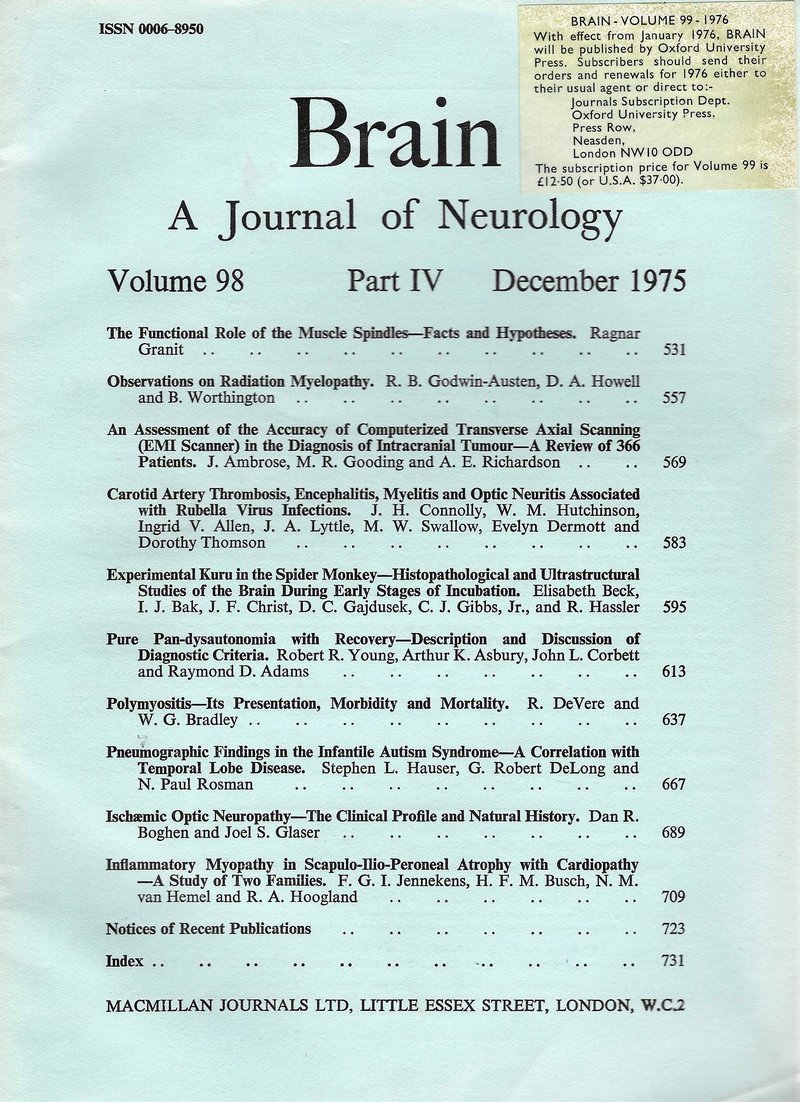
The issue for December 1975, the last published by Macmillan Co., with a slip pasted to the cover announcing the imminent move to Oxford University Press.
Against this background of growth for Brain, and collateral publishing by the Guarantors, dissatisfaction with Macmillan and Co. did not go away. When Ian McDonald (1933–2006) became treasurer and honorary secretary (1970–1977), the option of changing publisher was discussed. On 22 November 1973, it was agreed that Brain would now be published by Oxford University Press. The move came into effect with part I of volume 99 in 1976. As a result, wealth rapidly accumulated allowing the Guarantors increasingly to function as a charity supporting education and training in clinical and basic neuroscience.
1976–2023
After 1976, Brain faced competition as the premier neurological journal from rapid success of the newly founded Annals of Neurology. This erosion of position was fuelled by the belief that Brain mainly published long papers based on classical physiological methods which ignored the emerging technologies of experimental medicine.
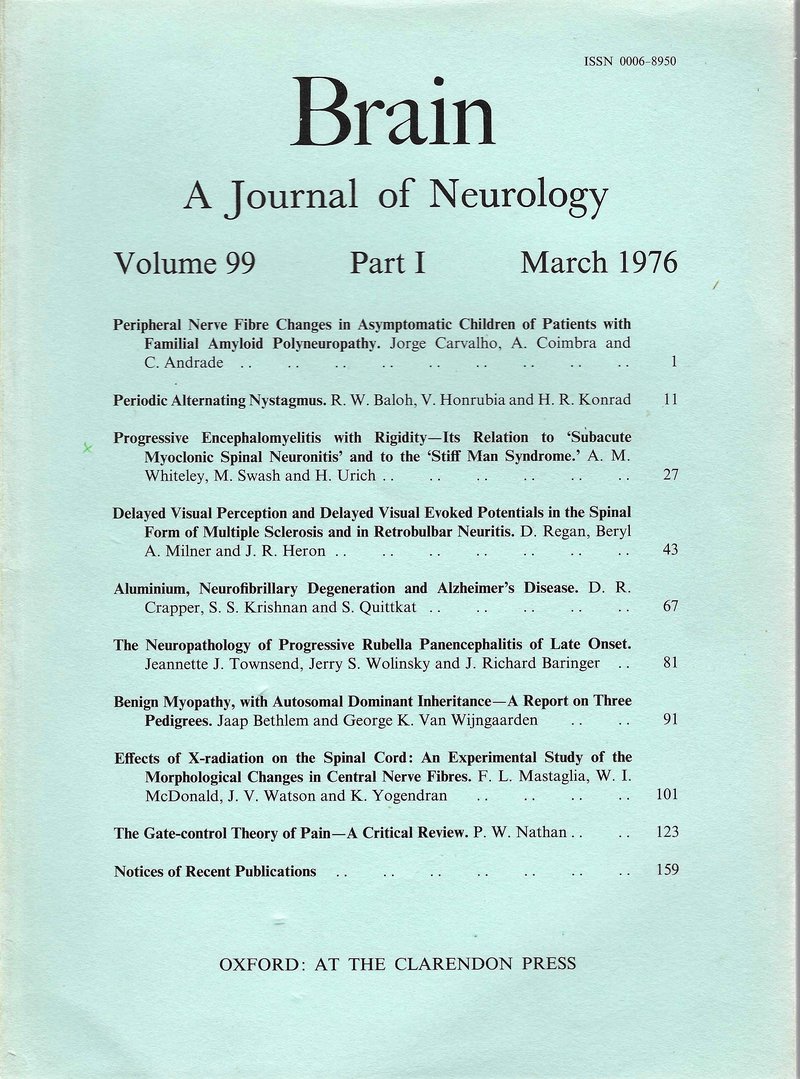
The issue for March 1976, the first published with the Clarendon Press imprint of Oxford University Press.
That perception did not immediately change with the appointment of Charles Phillips (editor, 1975–1981). He had published in Brain since 1940, usually with EGT (Edward) Liddell (1895–1981) in the Sherringtonian tradition of experimental physiology. Phillips arranged a centenary meeting for Brain on 5 April 1978 at the Royal College of Physicians; and celebrated the centenary of the International Medical Congress in 1881 when the confrontation between Ferrier and (Friedrich) Goltz (1834–1902) on localisation of function in the cerebral cortex took place. Although qualified in medicine, Phillips worked as a physiologist. He appointed a clinician, Ronald Henson (1915–1994), as deputy editor (1975–1981). When their terms ended, the Guarantors agreed at a meeting on 29 April 1981 that this combination of a clinician and basic scientist worked well and should continue.
The new editor, PK (Peter) Thomas (1926–2008; editor 1982–1991) appointed Lawrence Weiskrantz (1926–2018) as deputy (1982–1991). The advisory board comprised twelve individuals, five based outside the United Kingdom. Thomas had written in Brain since 1965. His office was a shoulder bag in which papers under consideration were scrutinised at all times throughout the working day and at weekends when not otherwise engaged. No other editor worked so tirelessly to create precision, economy of presentation and a fluent narrative for published manuscripts. Brain expanded considerably during his editorship. Page numbers doubled from around 900 per annum; and the decision was taken to increase the number of issues to six per year from 1986. The February 1991 issue was issued in two parts, together comprising 695 pages, in advance of his successor, Ian McDonald, being able to make a fresh start. The volume of Brain for 1991 contained 2723 pages with the list of contents spilling onto the otherwise blank back cover. Starting with a paper by his wife, Anita Harding (1952–1995) on the Drew family of Walworth, first drawn to attention of readers in Brain by Critchley and Fergus Ferguson (1899–1974) in 1929, Thomas completed the somewhat overdue process of making the contents of Brain attractive and relevant to the interests of readers, increasingly engaged in the new disciplines of experimental neurology.
PK Thomas was succeeded by Ian McDonald (editor 1991–1997) with John Clark (d.2013), a neurochemist, as deputy (1991–1996). The indomitable Elizabeth Macdougall retired and was replaced by Carol Lovelidge and Lubna Zahar, now based in the Brain editorial office rented from premises occupied by the Association of British Neurologists. McDonald’s editorial policy favoured brevity. The page numbers reduced but each issue was still bulky. Therefore, from February 1994, the format changed to larger paper, the text printed in double columns, and the contents no longer shown on the cover which now bore an image. Then, from January 1997, Brain moved to monthly publication so that the contents of each volume, now back at 2319 pages, were distributed across twelve issues each of around 200 pages. McDonald published forty-two papers in Brain between 1963 and 2007 (the last posthumously). His editorship coincided with the introduction of magnetic resonance imaging and, in line with the shift in his own research away from the physiology of demyelination and remyelination, during his tenure Brain published many papers on the use of imaging in understanding mechanisms of disease, especially multiple sclerosis. For McDonald, Brain was a treasured institution which he had influenced as secretary and treasurer (1970–1977). He wanted the journal to maintain the style and legacy of people such as Holmes, Symonds, Denny-Brown and other luminaries for younger generations who had not benefited directly from their teachings. McDonald followed the example of Brodal in publishing his experience of a small cerebrovascular episode leading to difficulties with musical performance and spatial organisation.
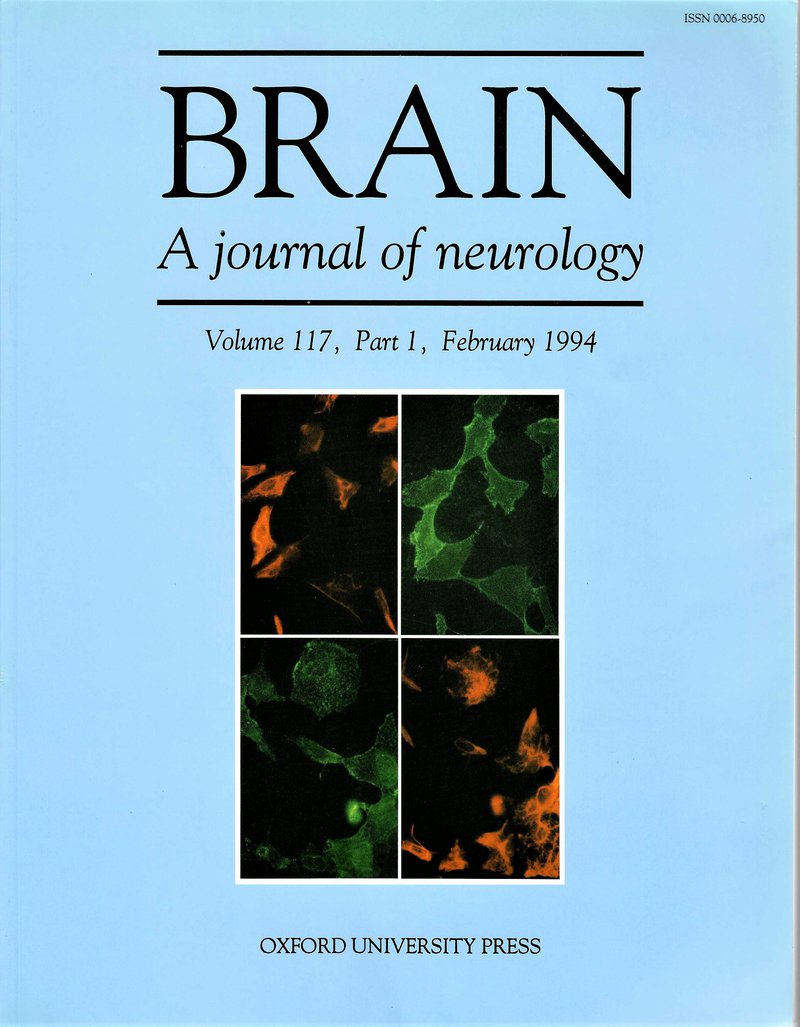
The issue for February 1994 on larger paper, the contents replaced by an image in colour taken from the paper on human astrocytes as antigen presenting cells.
His successor, John Newsom-Davis (1932–2007; editor 1998–2003) had served as secretary and treasurer (1977–1981), and chairman of the Guarantors (1994–1999). He had published in Brain since1970. His deputy editor was John Rothwell (from 1997–2003); and Newsom-Davis appointed an editorial board of twenty-two, nine based outside the United Kingdom. In 1998, 33% of accepted papers concerned normal structure or function many based on imaging techniques. Newsom-Davis served notice that, in future, papers in Brain must have a neurological orientation and be clearly relevant to the understanding of human disease. He promoted the disciplines of neuroimmunology and molecular genetics. In time, Brain stopped accepting normative studies. Newsom-Davis wrote an annual editorial; and scientific commentaries were reintroduced. During his editorship, Brain printed 17385 pages, increasing at around 15% per annum. In 2001, Newsom-Davis announced that Brain would manage 24-hour online processing in order to accelerate publication; and, from August 2003, paper copies of manuscripts were no longer accepted. Although this did allow Brain to handle more than 1000 papers submitted annually, the acceptance rate had to fall in order not to exceed the fixed page-limit for print. Correspondence was accepted but only published online. When Newsom-Davis demitted office, Brain was ranked first on citation index amongst clinical neurology journals. He had found the work onerous and likened the self-imposed burden of online access and round-the-clock editorial activity to the labour of Hercules in endlessly cleaning the Augean stables.
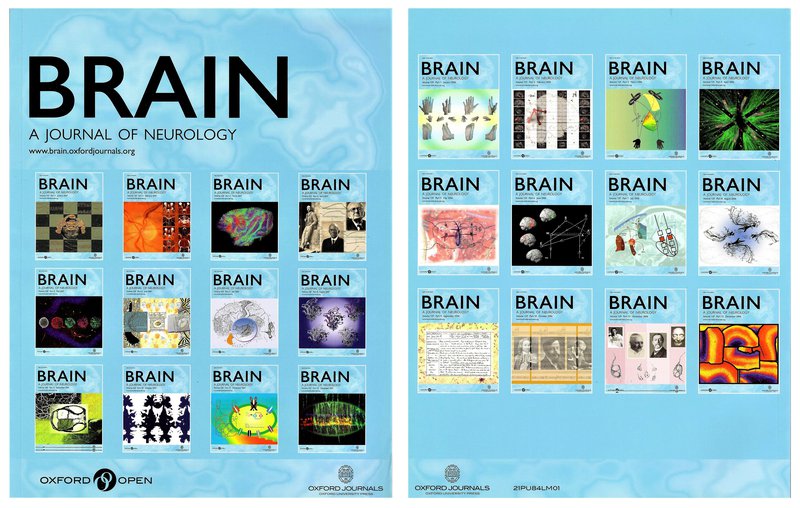
The front and back covers of the supplement issued in 2008 to be used as advertising material at scientific meetings, showing cover images from the previous two years.
The expansion in activity driven by online access continued during the decade in which Brain was edited by Alastair Compston (2004–2013). A former secretary and treasurer of Brain (1987–1991) and chairman of the Guarantors (1999–2004), he appointed an editorial board but no deputy. The journal was managed from an office in Cambridge by three employees: Eleanor Riches, Joanne Bell and Annemarie North. Compston wrote a monthly editorial which increasingly focused on the history of neurology. He wrote a second piece each month, ‘From the archives’, which summarised a paper previously published in Brain relating to an article in the current issue. He commissioned long book reviews, where possible drawing on authors who could address the clinical neurosciences from a diverse background. He included ‘occasional papers’ which were intended to engage the broader cultural and literary interests of readers. The covers of Brain became increasingly decorative and illustrative of an article in the current issue. Submissions increased to more than 2000 per annum; the acceptance rate remained low; the authorship and readership were increasingly international; and the impact factor rose. In 2008, intended as material to be distributed at scientific meetings in order to advertise Brain, Oxford University Press issued a supplement which reprinted with original page numbers one example from each of the various sections making up the contents, selected from issues published in the previous two years.
Dimitri Kullmann (editor 2014–2021) maintained the monthly editorials and introduced several new categories in order to accommodate papers that provided diversity but did not match the main focus on experimental and clinical neuroscience with an emphasis on disease mechanisms. Kullmann was the twelfth of eighteen editors to be elected a Fellow of the Royal Society, to date. He expanded the online features of the journal with brief synopses of each paper, scientific commentaries, podcasts and ‘editor’s choices’. Although Brain was still printed, the focus of activity had moved to the website and online access. Inheriting the administrative team from Cambridge, and also appointing Louisa Lyon, with each increasingly working remotely from home, in seven years the acceptance rate for articles in different categories was: editorials 82 / 82 (100%); scientific commentaries 329 / 334 (98%); reviews 79 / 224 (35%); updates 39 / 91 (43%); clinical trials 8 / 38 (22%); reports 114 / 1397 (8%); grey matters 40 / 136 (29%); from the archives 19 / 19 (100%); occasional papers 2 / 23 (9%); book reviews 53 / 53 (100%); letters 459 / 586 (78%); evoked responses 8 / 8 (100%); and original articles 1378 / 13398 (10%). Together, 2609 / 16389 (17%) submissions were accepted. Under Kullmann’s stewardship, the impact factor rose from 10.226 in 2013 to 15.225 in 2021. The exponential increase in submissions with a fixed page budget meant that many excellent papers, including those addressing normal brain function, were triaged or eventually rejected. At various times, through the officers and in discussion with Oxford University Press, the Guarantors had considered expanding the Brain stable. Eventually, in 2019, a second journal was launched, published online but not in print, with six issues per year: Brain Communications, edited by Tara Spires-Jones.

The first cover of Brain Communications, published online in 2019
Prior to 2021, the election of a new editor was based on soundings taken from each Guarantor in conversation with the secretary and treasurer. A more structured process was introduced for 2021 when the board of management held interviews in which applicants explained their plans for the journal, the preferred candidate then being approved by the Guarantors at their annual meeting. Masud Husain was appointed and returned to the style of having two assistants: Giovanna Mallucci and Ammar Al-Chalabi. They remain in office as of 2023. The existing sections were continued together with a reflective essay and editorial in each issue. Volume 145 for 2022 contained 4646 printed pages.
As treasurers, James Taylor, Anthony Feiling and Sam Nevin worried about the financial viability of Brain. Between 1964 and 1975, the costs charged by Macmillan and Co. for publishing the journal rose from £12845 to £54131 per annum with no increase in income to the Guarantors. Ian McDonald had seen the potential for improved financial security once the Guarantors were released from the punitive contracts with Macmillan. As a result, the task for McDonald’s successors was how best to find ways of disbursing increased income in line with the charitable status of the Guarantors. The next few treasurers were slow to act and merely let the bank balance grow with increasing amounts held on deposit: John Newsom-Davis (treasurer, 1978–1982); Michael Harrison (1936–2019; treasurer, 1983–1986); and Alastair Compston (treasurer, 1987–1991).
A few publishing ventures were undertaken at minimal cost to the Guarantors. At the suggestion of John Walton (1922–2016), responsibility for publication of Aids to the Investigation of the Peripheral Nervous System, first published as Aids to the Investigation of Peripheral Nerve Injuries by the Medical Research Council in 1942, passed to the Guarantors of Brain in 1986. Edited by Michael O’Brien this classic monograph encapsulates in pictures and a few words a very considerable amount of clinical neurology. It is now in its sixth edition. In 2000, Brain published as a special supplement to volume 123, ‘Visual disturbances following gunshot wounds of the cortical visual area’ by Tatsuji Inouye (1880–1976), based on observations of those wounded in the Japanese wars of 1900 and 1904–1905 and translated by Mitchell Glickstein (1931–2017) and Manfred Fahle (1951–2020).
Travel grants for attendance at scientific meetings were introduced. Success was high with every completed application duly approved. The first were awarded on 24 October 1979 to Christopher Kennard, Raymond Tallis and John Scadding. Sponsorship was granted for scientific meetings. For example, from 1991–2004 a residential course, free to one hundred delegates, on ‘Neuroscience for clinicians’ was hosted at Jesus College, Cambridge. Bursaries were also offered from 1979 which allowed distinguished clinicians to visit one or more centres in the United Kingdom. A lecture was instituted in the memory of Gordon Holmes to be given at a scientific meeting in the United Kingdom. The first was delivered by Günter Baumgartner (1924–1991) on 5 November 1983 on the occasion of the 50th anniversary of the Association of British Neurologists. In later years the lecture, funded by the Guarantors, was routinely given at meetings of the Association; but council decided to abandon the eponymous celebration of Holmes and other individuals in 2023.
These initiatives merely tinkered with the assets of Brain. The more recently appointed treasurers needed to play a much more strenuous role in managing the finances, fending off concerns from the Charity Commissioners that Brain was sitting on too much money: Richard Frackowiak (treasurer, 1992–1996); David Miller (1997–2001); Dimitri Kullmann (2002–2006); Geraint Rees (2007–2014); James Rowe (2014–2019); and David Sharp (from 2019). Working with fund managers, the returns on investment and sustained income from publication of the journal made Brain increasingly wealthy. Towards the end of the period in which Brain was published by Macmillan and Co. the bank balance was ca.£8500. By 2010, income was in excess of half a million pounds, and net assets six times that amount. Each has since increased annually. As a result, the Guarantors distributed more than £1M on charitable activities in 2022, an increase of 15% on the previous year. Salaries are provided at transitional points in the career structure of clinician scientists. Support is provided for those without medical qualifications to work in neuroscience. Short-term visiting fellowships commemorating the contribution of John Newsom-Davis are provided for neurologists from Eastern Europe. Grants are available for neurologists engaged in teaching and training in low-income countries. But, at a time when support from research councils and the major charities has weakened, the most creative scheme has been to fund an increasing number of three-year training fellowships for clinicians to work in basic neuroscience. Originally managed by the Board of Management, these resources are now passed to the Association of British Neurologists which, with other charitable benefactors, administers the ABN clinical training fellowships. As of 2023, there is no single price for Brain. Depending on print and / or online access, institutional rates vary from £806–£1279; corporate rates from £1008–£1596; and personal rates from £122–£407 per annum.
In 1878, four clinicians founded Brain, a journal of neurology. The immediate aim was to document knowledge on structure and function of the brain in health and disease. Their initiative coincided with the emergence of neurology as a specialty apart from general medicine. After a period of alignment with the Neurological Society of London (United Kingdom), Brain was owned and managed by forty Guarantors. With an increasingly strong financial situation from the end of the twentieth century following change in publisher, the Guarantors have responded by supporting the aim of the four founding editors and their illustrious successors both to publish a successful journal which documents current research and to promote training on the scientific basis of clinical neurology.
©Alastair Compston